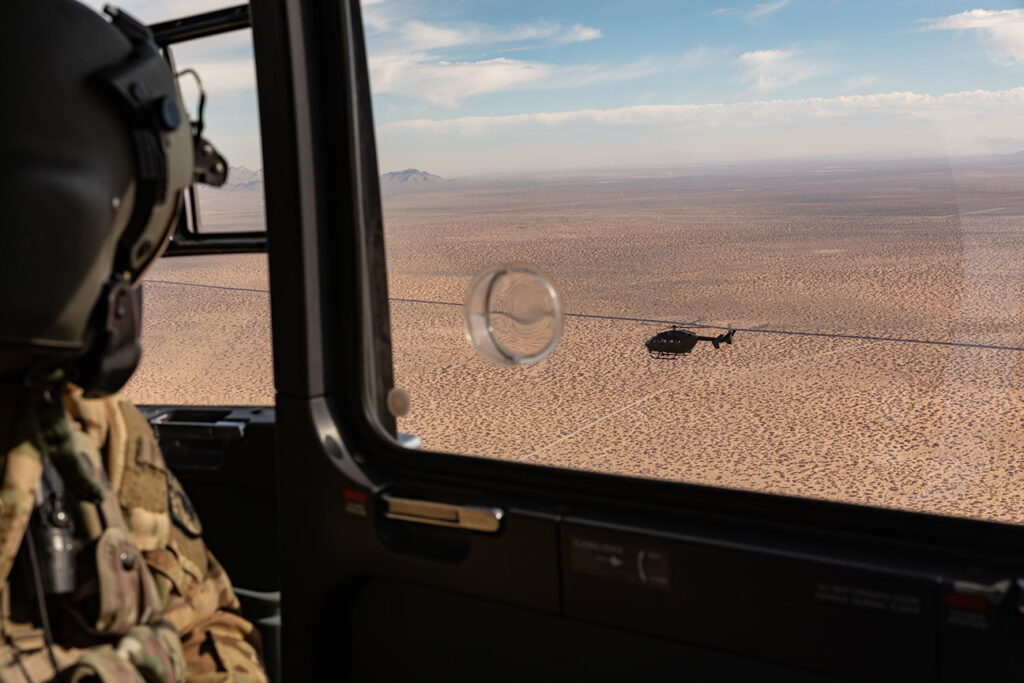U.S. Soldiers assigned to Task Force Sentinel survey the southern border wall in a UH-72A Lakota at Dona Ana, New Mexico, on February 22, 2025. U.S. Northern Command is working with the Department of Homeland Security to augment U.S. Customs and Border Protection along the border with additional military forces. PFC. DOMINIC ATLAS/U.S. ARMY
THE WATCH STAFF
The total number of troops deployed or scheduled to deploy to the U.S.-Mexico border has surged to more than 10,000, U.S. Northern Command (USNORTHCOM) said in a news release March 17. In the latest announcement, USNORTHCOM said about 400 service members, including about 385 Army engineers, would be deployed to the area.
Other service members will provide command and control and other staff functions for aviation operations, as well as medical logistics, USNORTHCOM said in the March 17 release. The timeline for the deployments has not been determined.
When he took office January 20, President Donald Trump quickly issued a series of executive orders to beef up security at the southern border after vowing to “seal the borders” and repel “unlawful mass migration.” Since then, a series of deployments have been announced, including:
January 22: The Pentagon announced it would send 1,5000 additional active-duty service members to the border, along with more air and intelligence assets. The troops will fly helicopters to help Border Patrol agents and aid in the construction of barriers, a Pentagon official said.
February 7: The Pentagon said it would deploy about 1,500 more active-duty Soldiers: The logistics brigade from the 18th Airborne Corps at Fort Liberty in North Carolina was being sent to help support and sustain troops in the region.
March 1: The Pentagon ordered about 3,000 additional active-duty troops to the border, including Soldiers from a motorized brigade equipped with 20-ton armored Stryker combat vehicles and a General Support Aviation Battalion. Defense Secretary Pete Hegseth ordered the deployment of the Stryker unit from the 4th Infantry Division’s 2nd Stryker Brigade Combat Team at Fort Carson, Colorado, and a helicopter battalion from the 3rd Combat Aviation Brigade at Fort Stewart, Georgia, to “reinforce and expand current border security operations to seal the border and protect the territorial integrity of the United States,” Pentagon press secretary Sean Parnell said in a statement.
March 11: USNORTHCOM announced that more than 600 additional service members will be deployed, including about 40 intelligence analysts from Air Force active-duty and Reserve units and about 590 engineers from the Army Corps of Engineers and the 18th Airborne Corps. The engineers will come from Fort Bragg, North Carolina; Fort Knox, Kentucky; and Fort Johnson, Louisiana.
USNORTHCOM said in its March 17 news release that the number of personnel at the border will fluctuate as units rotate personnel and as more forces are deployed after plans are finalized. About 2,500 National Guard and Army Reserve troops were already at the U.S.-Mexico border when Trump took office.
On a visit to the border on February 3, Hegseth said: “The ability to control every portion of the border — underneath, above ground, [by air] and by sea is something we take very seriously, and we will ensure [that happens] as rapidly as possible.”

